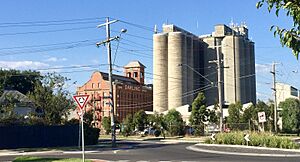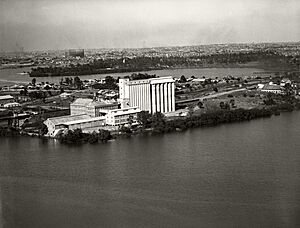John Darling and Son facts for kids
John Darling and Son was a very important Australian company that bought and sold wheat and also turned it into flour. For many years, it was the biggest company of its kind in Australia! It started in Adelaide, South Australia.
The company was founded by John Darling Sr. (1831–1905). He was a businessman from Scotland and also a Member of Parliament for 25 years. After him, his oldest son, John Darling, Jr. (1852–1914), took over. He was also a Member of Parliament. Later, Harold Gordon Darling led the company. In 1953, it became a private company in Victoria with three directors: Norman Darling, Leonard Darling, and Leonard Gordon Darling.
Contents
The Beginning of the Company
John Darling Sr. was born in Edinburgh, Scotland, in 1831. His family wasn't rich, and he had to leave school when he was only 11 years old because his father passed away.
He had a few jobs, like working in a printing shop and a type foundry. He worked for one company, James Marr, Gallie, & Co., for about 12 years. Many of his friends had moved to South Australia, and John realized there weren't many chances to get ahead in Edinburgh. So, he decided to follow them. He wasn't wealthy enough for a free trip, so it took some time for him and his family to save up and move.
How the Business Grew
In 1855, John Darling, his wife, and their two sons arrived in Semaphore, South Australia. He quickly found work, first in a store and then with a baker. After two years, he started his own small business with a horse and cart. He also helped his wife open a small shop.
Later, he worked for James Smith, who owned a flour mill. For five years, John learned all about the wheat and flour business. In 1865, he started trading on his own. By 1867, he was managing large grain stores.
In 1872, John Darling made his oldest son, John Darling Jr., a partner. The company then became known as J. Darling & Son. For 30 years, the business grew a lot. John Darling Sr. was even called the "Grain King"! He opened branches all over South Australia where wheat was grown. He also bought flour mills and set up offices in Melbourne in 1880 and even in London. His company handled most of Australia's wheat that was sent overseas.
John Darling Sr. retired in 1897, leaving his son, John Darling Jr., in charge. John Darling Sr. passed away suddenly in 1905. Under John Darling Jr., the company bought more flour mills and started a business that pressed hay in Gawler. John Darling Jr. passed away in 1914 in Melbourne.
Ships and the Sea
To move all that wheat and flour, John Darling and Son needed ships! In 1884, they had a coastal steamer called the Jessie Darling built. This ship carried grain from different ports in South Australia to Adelaide and Melbourne.
The Jessie Darling was involved in some accidents. One very unusual event happened in 1907. A large ship called the Norma, full of wheat, was hit by another steamer, the Ardencraig. Both ships sank, and one person drowned. Hours later, the Jessie Darling, also full of wheat, accidentally hit the sunken wreck of the Norma and sank too! Luckily, the Jessie Darling was later pulled out of the water, repaired, and put back into service.
The company also owned other ships like the Grace Darling, Palmerston, Emu, and Avoca. They even chartered a ship called the Templemore to carry wheat to Britain, but it was wrecked in 1893.
The Third Generation of Leaders
John Darling Jr. had four sons. One of them, John Darling III, had an accident and couldn't run the business. So, his brothers Harold and Leonard took on the responsibilities.
Another son, Joe Darling (1870–1946), became famous as the captain of the Australian Cricket Test team from 1897 to 1905!
Harold Gordon Darling
Harold Gordon Darling (1885–1950) was the oldest son of John Darling Jr. He joined the family business in 1903. He is most famous for being the chairman of BHP, a very large mining company in Australia.
Harold Gordon Darling held many important positions:
- He became the manager of John Darling and Son after his father passed away in 1914.
- He was on the board of BHP from 1914 and became its chairman from 1923 to 1950. During his time, BHP grew a lot!
- He was part of the Australian Wheat Board during World War I.
- He was also chairman of other big companies like Australian Iron & Steel and Commonwealth Aircraft Corporation.
- He was a director of the National Bank of Australasia.
Even though he was very influential, Harold Gordon Darling didn't like being in the spotlight. He rarely spoke in public. In 1929, he gave £10,000 to start the Waite Soil Research Centre in Adelaide. He even wished the gift didn't have to be made public! He passed away in 1950, leaving behind his wife, a son, and two daughters.
Other Family Members
Leonard Gordon Darling, also known as Gordon, was Harold Gordon Darling's nephew. He was a businessman and also a kind person who helped fund the National Portrait Gallery in Canberra.
What Happened Later
In 1962, the company John Darling and Son (Aust) Ltd. was bought by another company called Allied Mills. Then, in 1986, Allied Mills was taken over by Fielder Gillespie Davis Limited. So, the original John Darling and Son company became part of these larger groups over time.
Images for kids
-
John Darling & Son mill in Rhodes, New South Wales





